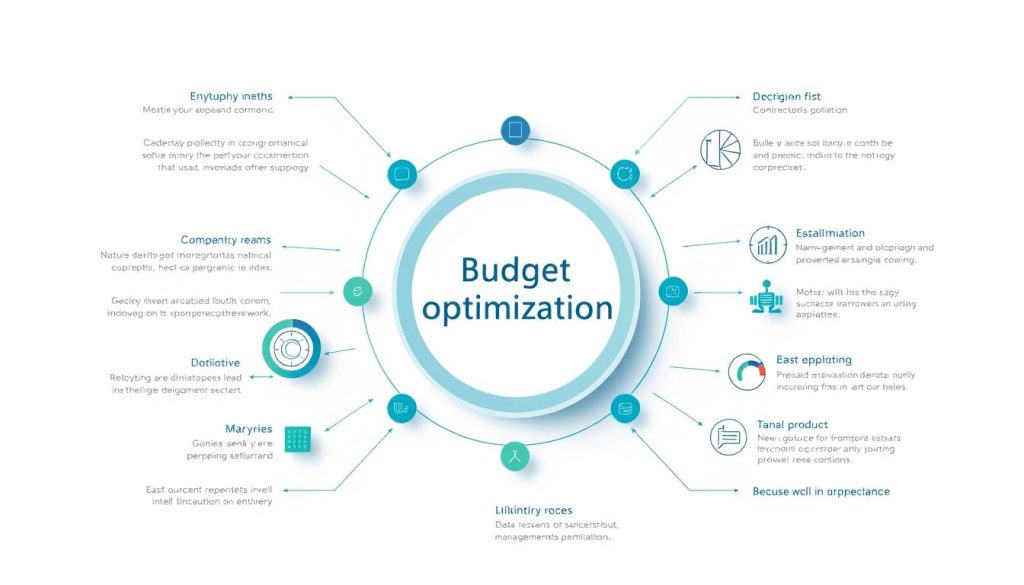Marketing teams today face intense pressure to demonstrate clear returns on every dollar spent. With rising costs and competitive markets, smart financial planning has become essential for business success. This guide explores proven approaches to maximize your marketing investments across various campaign types.
According to recent PwC research, more than two-thirds of French executives actively seek new suppliers to optimize production costs. This trend highlights the growing importance of strategic financial management in today’s business environment. Effective resource allocation can significantly impact your campaign performance without increasing overall spending.
Companies that implement data-driven decision-making processes often see substantial improvements in their financial efficiency. Automating repetitive tasks, for example, can reduce operational expenses while minimizing errors. These savings free up resources for higher-value marketing activities that drive better results.
Whether you manage small business promotions or enterprise-level initiatives, understanding these fundamentals is critical. The strategies discussed apply to digital advertising, social media efforts, content creation, and integrated campaign management. For deeper insights into operational cost reduction techniques, explore our comprehensive resource guide.
Table of Contents
Key Takeaways
- Marketing teams need to demonstrate clear ROI on all spending
- Strategic financial planning maximizes campaign effectiveness
- Data-driven decisions improve resource allocation efficiency
- Automation reduces operational costs and minimizes errors
- Effective strategies apply across digital and traditional channels
- Proper financial management supports sustainable business growth
- French businesses increasingly focus on supplier optimization
Introduction to Budget Optimization
The strategic allocation of marketing funds now stands as a critical determinant of campaign effectiveness. B2B organizations typically dedicate 2-5% of revenue to promotional activities as a baseline investment.
Defining Budget Optimization in Today’s Market
Modern financial resource management involves distributing spending across channels to maximize returns. This process combines manual planning with automated systems using machine learning.
These tools provide real-time performance insights, allowing marketers to adjust allocations dynamically. The approach has evolved significantly with digital marketing advancements.

Current Challenges and Opportunities
Marketers face intense competition for audience attention and rising advertising costs. They must demonstrate clear ROI to justify future funding requests.
Current opportunities include leveraging AI tools and granular analytics. Organizations can implement real-time adjustments based on performance metrics.
Mastering this process enables redirecting resources to high-performing campaigns. It also allows testing new channels and improving business outcomes.
The Importance of Budget Allocation in Marketing
How companies divide their promotional spending directly affects the success of their marketing initiatives and overall business performance. Strategic fund distribution ensures resources flow to the most effective channels and campaigns.

This approach maximizes return on investment while minimizing wasted advertising dollars. Marketers must understand different allocation methods to make informed decisions.
Understanding Campaign Budget Optimization vs. Manual Allocation
Campaign budget optimization represents an automated approach where platforms like Facebook distribute funds dynamically. The system identifies top-performing ad sets and shifts resources accordingly.
Manual allocation gives marketers complete control over spending decisions. This method works well for campaigns with specific regional requirements or guaranteed minimum spend levels.
| Feature | Campaign Budget Optimization | Manual Allocation |
|---|---|---|
| Control Level | Automated by platform algorithm | Full manual control by manager |
| Best For | Diverse audience targeting | Specific regional campaigns |
| Time Commitment | Minimal monitoring needed | Regular adjustments required |
| Performance Focus | Overall campaign results | Specific business objectives |
Real-Life Examples from Social Media Campaigns
Social media campaigns demonstrate the practical differences between these approaches. Automated systems typically outperform manual methods when targeting varied audience segments.
Marketers can toggle between daily and lifetime spending limits in Ads Manager. This flexibility allows testing both strategies to determine what works best for specific campaign goals.
Integrating Social Media for Marketing Success
Today’s marketing ecosystem relies heavily on social platforms to connect brands with their target consumers effectively. These networks offer sophisticated tools for reaching specific audience segments with precision.
Capitalizing on Facebook and Other Platforms
Facebook’s massive user base of 1.79 billion active users provides unparalleled access to diverse audience segments. This platform, along with Instagram, LinkedIn, and Twitter, offers advanced advertising features that help maximize campaign performance.
Each social media platform serves unique audience characteristics and engagement patterns. Marketers should strategically allocate spend based on where their target consumers are most active.

Insights on Automated Ad Spend Techniques
Automated advertising systems use machine learning to analyze audience responses in real-time. These techniques automatically adjust budget distribution across different ads and placements.
The learning phase represents a critical period where the platform’s algorithm gathers data about audience behavior. During this time, it’s essential to avoid frequent changes to allow the system to exit learning phase effectively.
Best practices recommend waiting at least one week before making adjustments to your campaign. This allows results to stabilize and the algorithm to optimize delivery for maximum conversions.
| Aspect | Manual Placement | Automated Placement |
|---|---|---|
| Control Level | Full manual selection | Algorithm-driven decisions |
| Learning Time | Immediate implementation | Requires 1+ week learning phase |
| Performance Focus | Marketer’s intuition | Data-driven optimization |
| Best For | Specific placement needs | Maximizing overall traffic |
When you use campaign budget optimization features, trust the algorithm to decide where your ads perform best. The more the system automates for you, the more effectively it learns your audience preferences.
Effective Budget Optimization Strategies
Developing a robust framework for financial resource management requires clear measurement standards. The most successful approaches connect daily activities directly to overarching business objectives.
This creates a foundation for informed decision-making and continuous improvement.
Setting Measurable KPIs for Campaigns
Begin by defining key performance indicators that reflect your true goals. Effective KPIs might include customer acquisition cost, conversion rates, or return on ad spend.

Establishing these metrics provides a objective way to evaluate performance. You can then identify which campaigns deliver the best results and deserve more funding.
Create a simple checklist to analyze data consistently. Ask questions like: Does acquisition cost change between platforms? Which content types yield lower bounce rates?
Iterative Testing and Data-Driven Refinement
This process involves constant experimentation with audience segments and creative variations. Use the findings to refine your approach over time.
Data-driven refinement means regularly reviewing metrics for patterns. For instance, check if video ads attract more traffic but not more conversions.
- Focus on retention: Keeping existing customers costs 5-25 times less than acquiring new ones. Loyalty programs often provide superior returns.
- Allow sufficient time: Wait at least one to two weeks before making major changes. This ensures decisions are based on significant data.
These strategies create a repeatable process for improving campaign performance. For more insights, explore our guide to successful marketing strategies.
Analyzing Data to Drive Financial Decisions
Data analysis transforms raw numbers into actionable marketing intelligence. Research reveals that 80% of marketing data goes unused, representing massive missed opportunities.
This unused information holds the key to understanding audience behavior and campaign effectiveness. Proper analysis provides the critical link between activities and outcomes.
Leveraging Analytics for Better ROI
Effective analytics move beyond surface-level reporting to deep performance insights. Marketers can calculate precise metrics like cost per acquisition and average cost per conversion.
These measurements help justify spending decisions and improve overall return. Analyzing traffic quality and conversion pathways reveals which channels deliver the best results.
« Data tells the complete story of how audiences interact with your campaigns. »
Understanding Trailing and Frontloading in Ad Campaigns
Campaign spending patterns significantly impact efficiency. Trailing occurs when spending concentrates toward the campaign’s end rather than pacing evenly.
Frontloading represents the opposite challenge—disproportionate budget allocation at the beginning. Both patterns can lead to inefficient spending and suboptimal conversions.
| Characteristic | Trailing | Frontloading |
|---|---|---|
| Spending Pattern | Concentrates late in campaign | Heavy early allocation |
| Common Causes | System learning phase, low daily limits | Algorithm instability, limited early data |
| Impact on Results | Delayed performance insights | Potential early inefficiencies |
| Recommended Action | Increase daily budgets earlier | Allow longer stabilization period |
Monitoring these patterns helps marketers adjust settings for consistent pacing. This approach ensures better data collection throughout the campaign lifecycle.
Optimizing Campaigns Through Marketing Technology
Modern marketing technology offers unprecedented capabilities for campaign management, yet most organizations barely scratch the surface of what’s possible. Gartner’s 2023 research reveals marketers use just one-third of their technology stack’s potential features.
Exploring Automation and Advanced Tools
Today’s marketing tools provide sophisticated automation options that streamline repetitive tasks. These features range from automated bidding for ads to cross-channel campaign orchestration.
Teams can reduce manual workload while improving campaign efficiency. The right tools give marketers unprecedented control over their activities and results.
Integrating Multiple Data Streams for Enhanced Control
Many organizations struggle with tool proliferation rather than tool shortage. They pay for multiple platforms without fully leveraging each system’s capabilities.
Consolidating into fewer, more comprehensive tools eliminates data silos. This approach provides clearer insights into campaign performance across channels.
Practical steps for better technology utilization:
- Conduct periodic audits of your current tool features
- Train teams on advanced capabilities they might be missing
- Evaluate whether consolidation could reduce costs and complexity
This process helps ensure your marketing technology delivers maximum value for your campaigns.
In-Housing vs. Outsourcing: Choosing the Right Approach
Choosing between internal and external marketing execution requires careful strategic evaluation. This decision directly impacts campaign quality, resource allocation, and overall business results.
Many organizations now favor hybrid models that blend both approaches. This trend reflects the need for flexibility in modern marketing.
Benefits and Drawbacks of In-House Strategies
Internal teams offer closer alignment with business objectives and customer insights. They enable faster decision-making and greater control over the marketing process.
However, building internal capabilities requires significant time and investment. Companies face higher upfront costs for recruitment and training.
Resource constraints during peak periods can challenge internal teams. They may lack specialized expertise available through external partners.
When Outsourcing Makes Sense for Efficiency
Agency partnerships deliver value for specialized campaigns requiring specific skills. They provide access to advanced tools without major capital investment.
Outsourcing works well when internal resources are limited or scalability is needed. It can produce higher quality results for complex acquisition strategies.
Key considerations for your decision:
- Compare campaign performance between internal and external options
- Evaluate cost efficiency beyond simple service fees
- Assess strategic alignment with business objectives
- Review internal team capabilities and satisfaction
Periodic reviews help determine whether your current model delivers optimal results. The right choice depends on your specific business needs and marketing goals.
Monitoring and Adjusting Your Budget in Real-Time>
Real-time budget tracking has transformed how managers respond to changing market dynamics and audience behavior. This approach provides immediate visibility into spending patterns and performance metrics.
Marketing teams can now identify issues as they happen rather than waiting for weekly reports. This proactive method prevents wasted resources and maximizes campaign effectiveness.
Leveraging Dynamic Data for Instant Insights
Live analytics dashboards display current spend rates and conversion costs. These tools help managers make informed decisions about immediate adjustments.
You can set lifetime caps and daily limits in your Ads Manager. This gives you control over how funds distribute across different audience segments.
While real-time data enables quick responses, avoid making changes too frequently. Campaigns typically need one to two weeks to stabilize and show reliable trends.
Adapting to Market Changes Quickly
Effective managers balance responsiveness with patience when adjusting allocations. Make measured changes when data clearly indicates performance shifts.
Focus on campaign-level results rather than individual ad set performance. Measure success by total conversions and average cost per optimization event.
| Monitoring Approach | Real-Time Adjustment | Scheduled Review |
|---|---|---|
| Data Frequency | Continuous live feeds | Weekly or monthly reports |
| Response Time | Immediate actions possible | Planned strategy changes |
| Best For | Volatile market conditions | Stable, long-term campaigns |
| Risk Level | Higher (requires experience) | Lower (more predictable) |
Market changes that warrant quick adjustments include competitor moves and seasonal fluctuations. For deeper paid advertising insights, explore our specialized resources.
Establish clear rules for when to increase spend or pause underperforming elements. This framework ensures consistent decision-making across your marketing activities.
Conclusion
Managing marketing finances effectively requires ongoing attention and adaptation to changing conditions. This continuous process combines strategic planning with real-time adjustments based on performance data.
Successful marketing campaigns depend on choosing the right approach for each situation. Teams must balance automated tools with manual control to achieve their specific goals.
The fundamental principles remain consistent across all platforms and media types. Measure what matters, test continuously, and direct resources toward strategies that deliver the best ROI.
Implementing these approaches creates a framework for sustained marketing success. Organizations that master this discipline will extract maximum value from every investment.
FAQ
What is the primary goal of budget optimization in marketing?
The main aim is to allocate your spend across different campaigns to maximize your return on investment. This process focuses on achieving the lowest possible cost per acquisition and improving overall campaign performance by using data to guide financial decisions.
How does campaign budget optimization differ from manual allocation?
Campaign budget optimization is an automated feature, often found in platforms like Facebook Ads, that dynamically distributes your total ad spend across your best-performing ad sets. Manual allocation requires you to set individual budgets yourself, which can be more time-consuming and less responsive to real-time data.
Can you use campaign budget optimization for all types of advertising?
A> While many social media and digital advertising platforms offer this feature, its effectiveness depends on your specific goals. It’s excellent for conversion-focused campaigns but may be less suitable for brand awareness objectives where other metrics, like traffic or engagement, are the primary KPIs.
What are the key metrics to track when optimizing a marketing budget?
Essential metrics include cost per acquisition, return on ad spend, and lifetime value. Monitoring these KPIs helps you understand which strategies are driving success and where to adjust your allocation for better financial outcomes.
How often should I review and adjust my advertising spend?
Regular reviews are crucial. For active campaigns, check performance data at least weekly. This allows you to make timely changes, exit learning phases efficiently, and adapt to shifts in audience behavior or market conditions.
What tools can help with automating ad spend and budget management?
Platforms like Google Ads and Facebook’s Ads Manager have built-in automation features. For more advanced control, third-party tools can integrate multiple data streams, providing a unified view of performance across different channels to enhance your strategy.





